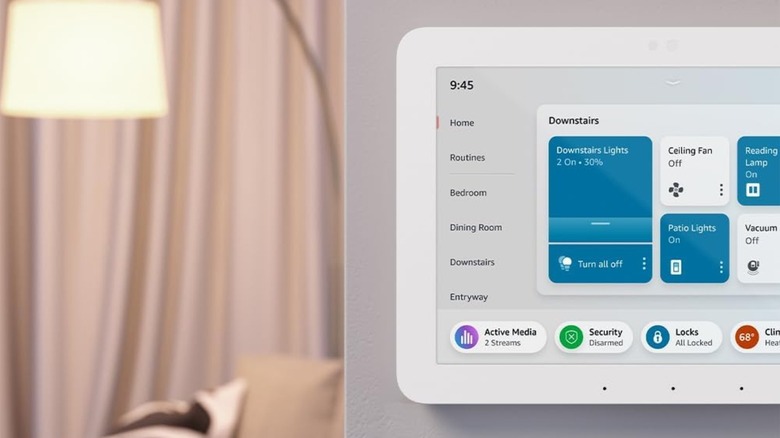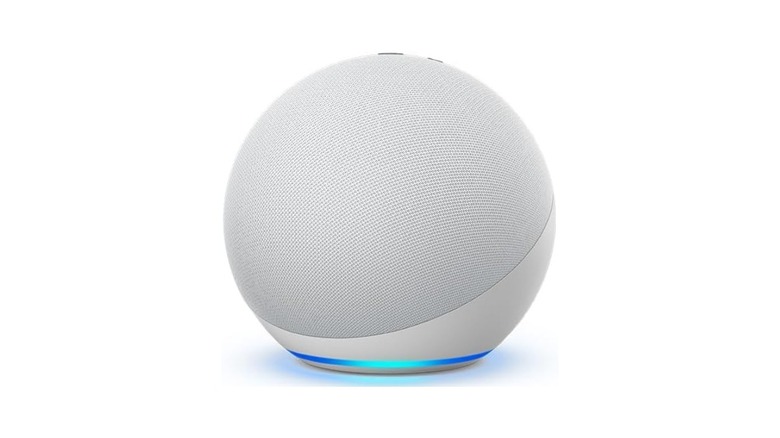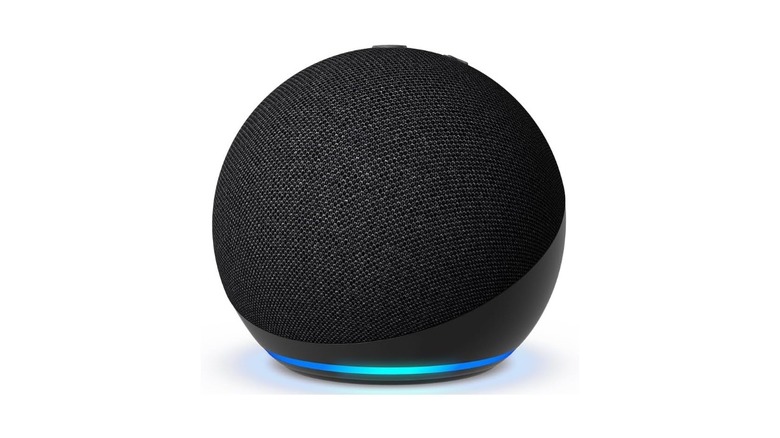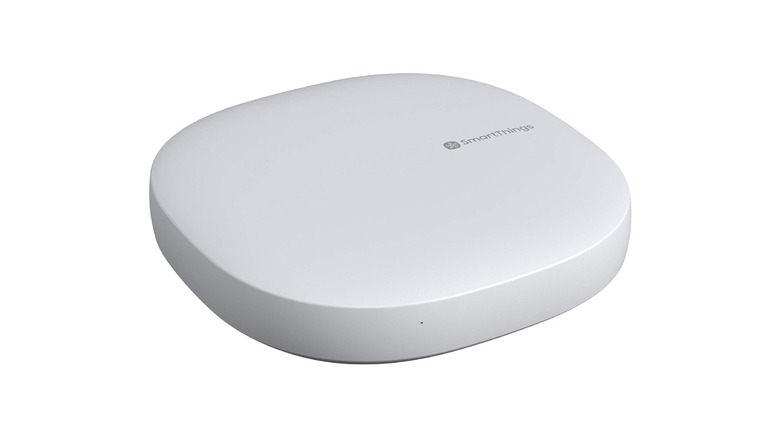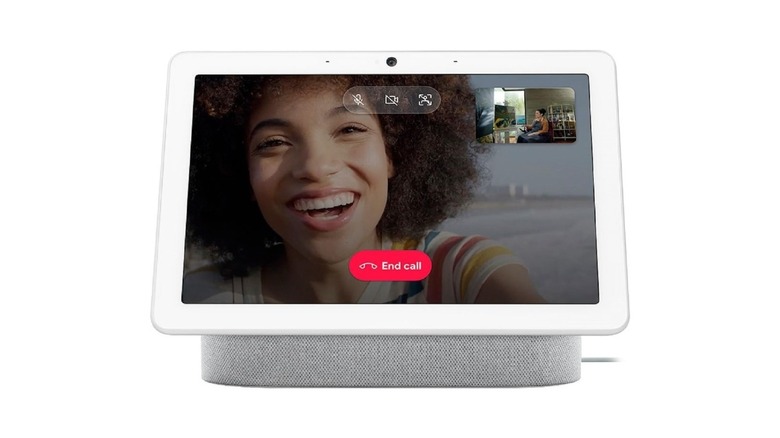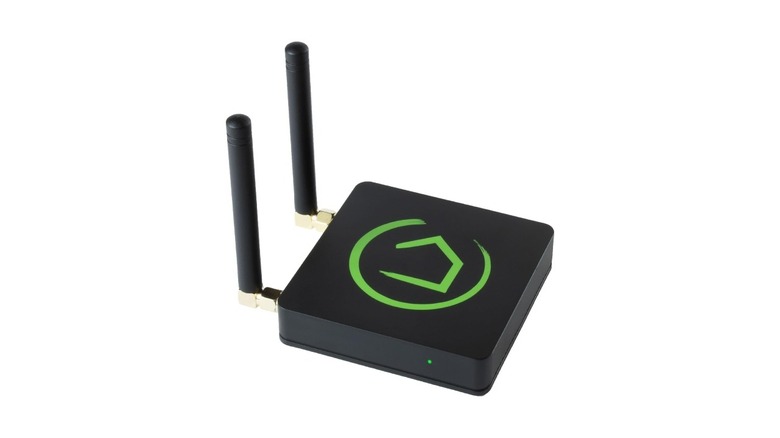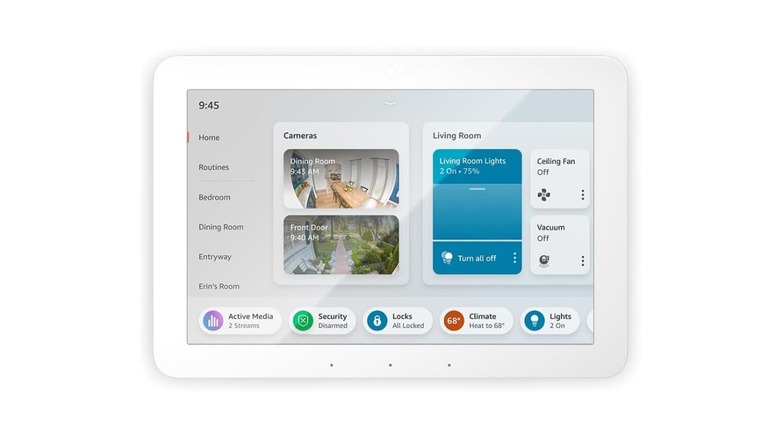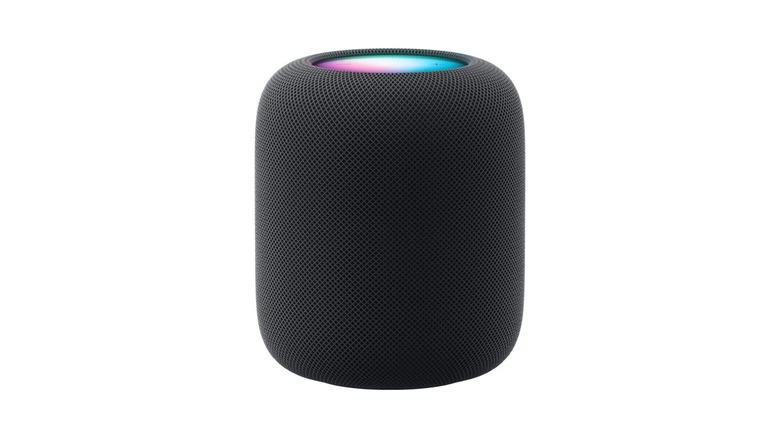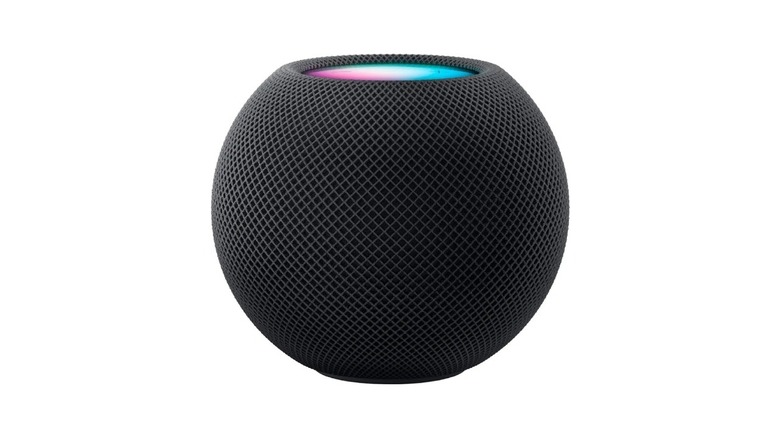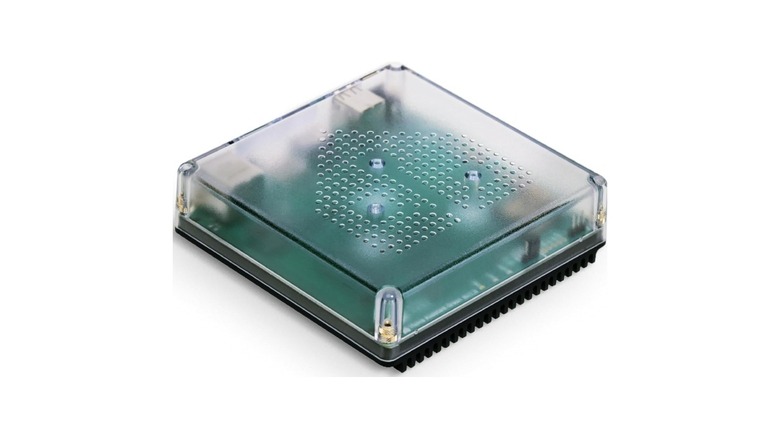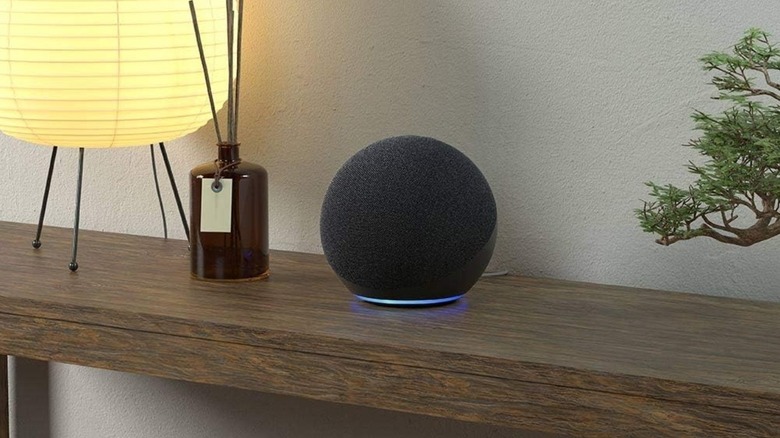9 Of The Best Smart Home Hubs To Get You Started
We may receive a commission on purchases made from links.
With technology evolving so fast and most everyday objects getting smarter, it only makes sense to add smart capabilities to your home. Smart home devices and gadgets can make your life a lot easier by adding a dash of convenience to mundane tasks. Whether it's switching on lights, ACs, and appliances or opening your living room curtains or garage door, a smart home ecosystem is an absolute blessing to automate several tasks. If you decide to dip your toes into the smart home world owing to this, the first step would be to determine which smart home hub you're going with. A hub is the backbone of a smart home ecosystem since all the gadgets and sensors you pick will work in tandem with it.
It ties together your smart bulbs, smart speakers, smart locks, and Wi-Fi security cameras — so that they can all work together seamlessly. Whether you want your curtains to open as soon as the sun rises or you want your AC to turn on as soon as your Wi-Fi garage door opener gets triggered, I'll be touching on 10 of the best smart home hubs that will enable the best and most useful automations. We've included options for beginners, enthusiasts, and experts — we have you covered if you're just looking for something plug-and-play.
On the other hand, if you love tinkering around with tech and want to build a comprehensive smart home system that's customizable with multiple devices, there's something for you as well.
Amazon Echo 4th Generation
Amazon's flagship Echo speaker has undergone a substantial change over the years. It has been redesigned from a tall cylindrical speaker into a spherical one, similar to the Echo Dot. Since it's more premium than the Echo Dot, the Amazon Echo 4th Generation's sound quality is better across parameters. Everything from the bass response to the vocals sounds better than the Echo Dot or the more recent Amazon Echo Pop. Apart from being an excellent speaker, the Echo has Alexa built-in, which can answer all your queries and control connected devices. You can simply ask your lights to be turned on or your curtains to be closed using voice commands.
As for connecting external devices, the Echo speaker supports Wi-Fi, Bluetooth, Zigbee, Matter, Thread, and Amazon Sidewalk protocols. If you have a device or sensor that supports any of these protocols, you can use it with your Echo. Notably, the Echo has one of the widest ranges of supported devices and protocols, making it an excellent option for most people. You can even connect Philips Hue lights without a bridge, which isn't too common. If you're a beginner who wants a hub that readily works with a whole bunch of devices available in the market, the Amazon Echo is a solid option that doesn't cost too much and gives you a fantastic speaker as a bonus.
Amazon Echo Dot 5th Generation
If you don't want to spend a hundred bucks on a smart home hub and don't mind giving up on a few supported protocols, the Amazon Echo Dot is a fantastic option. It costs half of what the standard Echo does while maintaining most of the core functionality. The design is equally premium, and the audio quality via the speaker is superb. It's not as good as the Echo, but it certainly punches well above its weight. It's a slight improvement over the Echo Dot 4th generation, which was already excellent. Apart from the high-quality audio, Alexa — the onboard voice assistant — can be used to perform the same set of tasks that are possible on the Echo. You can turn on your AC, play your favorite songs, or automate your coffee machine to turn on every morning as you wake up.
While the core functionality remains the same, the Echo Dot misses out on a few protocols that its elder sibling supports. It only has support for Wi-Fi, Bluetooth, and Matter. Zigbee is a popular protocol that many smart home gadgets and sensors use. If you have any of those, they won't connect to the Echo Dot, so it's important to identify all the devices you're going to use as a part of your smart home and then determine whether the Echo Dot will suffice your needs or if you'll have to splurge and get the more expensive Echo.
SmartThings Hub
Since both the Echo and the Echo Dot have built-in speakers, they occupy a decent bit of vertical space on a table. The SmartThings Hub, on the other hand, has a flat puck-like design that barely takes up any real estate. In fact, it also doubles up as a 15-watt wireless charger for your phone, so it offers more utility than being a device that you just place on a surface. It may not have a speaker to play your favorite songs or respond to queries using your voice, but it supports a huge set of devices that can be linked and controlled via Samsung's SmartThings app. As for the protocols, it supports Wi-Fi, Bluetooth, Zigbee, Matter, and Thread. While it does miss out on Z-Wave, it's compatible with both Nest devices, thanks to Matter support, and those powered by Zigbee, which is nice.
If you have devices that use multiple smart home protocols or you wish to have sensors across multiple ecosystems, the SmartThings hub is a reliable option. The companion app has a simple UI that makes adding new devices and controlling existing ones easy. It's always nice to have some flexibility when you're starting to build a smart home ecosystem, and the SmartThings hub offers just that. If you have a Samsung smartphone, the SmartThings app comes pre-installed and is well integrated into the phone's UI, making this an even more obvious pick.
Google Nest Hub Max
The Google Nest Hub Max is one of the best smart displays that also happens to be a smart home hub. Not only is the display large and vibrant, but it's also plenty useful for various tasks and purposes. Obviously, the primary use case is controlling all the connected devices, like smart bulbs, switches, plugs, etc., around the house. Apart from that, though, the display can be used to watch YouTube videos, Netflix shows, and pretty much any content via a streaming platform. It can also be used to make video calls via the onboard camera or view who is at the front door if you happen to have a doorbell camera at your home or office.
Along with the large 10-inch display, the accompanying speaker on the Nest Hub Max is also among the best in the business, thanks in large to the form factor and Google's tuning. Of course, there's support for Google Assistant via the speaker, so you can use voice commands and receive audio responses. While most of the features of the Nest Hub Max are impressive, the protocols supported by the device are a big letdown. You only get support for Wi-Fi, Bluetooth, and Thread — no Zigbee or Matter. Considering the asking price, this is a slight bummer. However, it's still an excellent option if you're only using smart home gadgets made for Google Assistant and if you specifically want a hub with a display for visual controls.
Hubitat Elevation
All the smart home hubs mentioned above were from large brands that are well-known in the home automation space. However, several lesser-known players offer universal smart home solutions that aren't restricted to certain protocols. For instance, the Hubitat Elevation hub Model C-8 is compatible with Wi-Fi, Zigbee, Z-Wave, and Matter. Thanks to this, you can use devices meant for Google Assistant, Alexa, HomeKit, and pretty much any other protocol with the hub. If you buy a hub from Google or Amazon, you won't get this level of flexibility since they will only be compatible with smart home devices made for their supported protocols. On the downside, you miss out on extra features like a built-in smart speaker or display.
Additionally, all the automations set on the Hubitat Elevation are processed locally, so none of the requests are sent to external servers. This ensures faster speeds, better reliability, and improved privacy in your smart home ecosystem. You can continue using your smart home system even if there's an internet outage — something that's not possible on smart home hubs that aren't hosted locally. Notably, the Rule Machine and webCoRE platforms used by Hubitat allow for highly customizable automations but the learning curve is rather steep. This means that it's not an ideal option for beginners but is rather catered toward enthusiasts who want granular customization and zero dependency on the cloud.
Amazon Echo Hub
If you're looking for a smart home hub from Amazon, the Amazon Echo — for all intents and purposes — is the most sensible option, since it supports a wide range of protocols and is also reasonably priced. The built-in speaker is impressive, too. However, it doesn't have a built-in display, which means you have to rely on the accompanying app or voice commands to control your connected devices. That's where the Amazon Echo Hub comes into the picture. It's a wall-mounted control panel system for your smart home that external devices and sensors can link to. It's similar to the Nest Hub Max in the sense that you get controls to all your smart home devices on the screen, making it easy to quickly adjust the required parameters like brightness, color temperature, schedule, etc., in a matter of a few seconds.
It supports all the Amazon Echo protocols, so the compatibility list includes Wi-Fi, Bluetooth, Zigbee, Matter, Thread, and Amazon Sidewalk. The display panel is the clear USP here since you can use it to view the camera feed from your Ring doorbell camera, get a visual representation of which lights are turned on where, and what temperature your thermostat is set to — all in one place. It is slightly pricey, but a cheaper hub with all the supported protocols, plus an external display to control the devices, is going to cost as much, making the Amazon Echo Hub a compelling option.
Apple HomePod 2nd generation
Apple also dipped its toes into the world of smart speakers with the HomePod back in 2018. While the first one didn't garner enough attention, the second iteration — the Apple HomePod 2nd generation — is a solid smart speaker that can also act as a smart home hub for several users. For starters, it's one of the most premium speakers on this list with the best audio quality. It can give dedicated speakers of this size and price range a run for their money. So, if you're looking for a decent-sized speaker, you can consider the HomePod for solely that purpose. However, you also get a nice set of features like built-in Siri, temperature, and humidity sensors.
While it misses out on Zigbee support like a typical Apple device (why would they even add support for devices and protocols outside the ecosystem?), the HomePod is compatible with Wi-Fi, Bluetooth, Thread, and Matter. That's a large set of smart home devices compatible with the HomePod. Once you link a HomeKit-compatible device, you can set and use automations via your smartphone through the Home app. If you wish to enjoy music while also catering to your smart home needs, you can't go wrong with the Apple HomePod 2. It's almost like killing two birds with one stone (so to speak) — stellar audio and solid functionality.
Apple HomePod mini
Just like the Amazon Echo and the Echo Dot, Apple also sells two versions of the HomePod. A bigger HomePod with a large emphasis on sound quality, and a smaller HomePod mini, which still focuses on providing high-quality audio but also on making smart home ecosystems more accessible to the masses. It's still rather steep at $99 since Amazon's Echo speaker also retails for the same price and offers support for more protocols. Despite that, the HomePod mini can be a preferred option for a lot of folks, especially if you have an iPhone. Just like most things Apple, it fits extremely into the ecosystem. If you want to play music from your iPhone on a HomePod, all you have to do is tap the iPhone at the top of the speaker. This level of integration is truly smart and convenient.
While the speaker still sounds good with slightly lesser bass, it only supports Wi-Fi, Bluetooth, Thread, and Matter protocols — just like its elder sibling. The Echo on the other hand also gets Zigbee support, which can be important since it's a popular protocol. It's up to you to decide if you want better cross-functionality with your iPhone and the rest of your Apple products or if you want a more universal smart home experience with a wider variety of gadgets and sensors. If your answer is the former, the HomePod mini is the option. For the latter, pick the Amazon Echo or the SmartThings hub.
Home Assistant Green
Unlike smart speakers, displays, or hubs from mainstream brands, the Home Assistant Green is an open-source smart home hub that caters to those who want to customize their gadgets exactly as per their requirements. It supports Wi-Fi, Zigbee, Z-Wave (with an extra add-on), and Matter — making it a universal solution. It missed out on compatibility with Thread, but that's forgivable since all the other major protocols are present. Just like the Hubitat hub, the Home Assistant Green also processes all your data locally, so there's no cloud server involved here. This is the best way to keep your data private, especially if you've installed cameras around the house.
The platform is community-driven, so if you run into any issues while using the device or you just can't figure out the Home Assistant UI, you can always seek help. Its highly customizable and open-source nature makes Home Assistant the default option for those who wish to build a smart home network without getting locked into a vendor. Needless to say, this level of customization and tuning requires some knowledge of all the various components, so there's definitely a steep learning curve to using a device like this. If you're open to DIY-ing your way through it, you certainly can't go wrong with the Home Assistant Green. In fact, you can even run Home Assistant on a Raspberry Pi, allowing you to save any extra hardware cost if you already have the SBC with you.
How we picked the smart home hubs
One of the most important factors when picking a smart home hub is determining the protocol you want to go with. This is going to decide what sensors, gadgets, and devices you get to connect to your smart home hub since certain smart home devices like bulbs, locks, fans, etc., only support certain protocols. Owing to this, we've included smart home hubs that support multiple protocols so you can pick the one that aligns with your requirements. If you're looking for a hub that supports Zigbee, the Amazon Echo is a good option. Similarly, you can choose from hubs that support Matter or Thread.
Additionally, we've also taken into account factors like ease of use, since connecting and interfacing sensors and devices with the hub should ideally be straightforward. You can also pick a hub that can also act as a speaker with a built-in voice assistant, or if you don't want to use voice commands. We've also included hubs that allow you to self-host your own smart home system so that your data completely remains with you locally and isn't sent to the cloud. However, these solutions may be slightly more complex and require technical know-how.
Depending on how much you're willing to learn and the amount of time you're willing to spend, you can set up your custom smart home ecosystem using any of these hubs with seamless integration with sensors and other gadgets.
